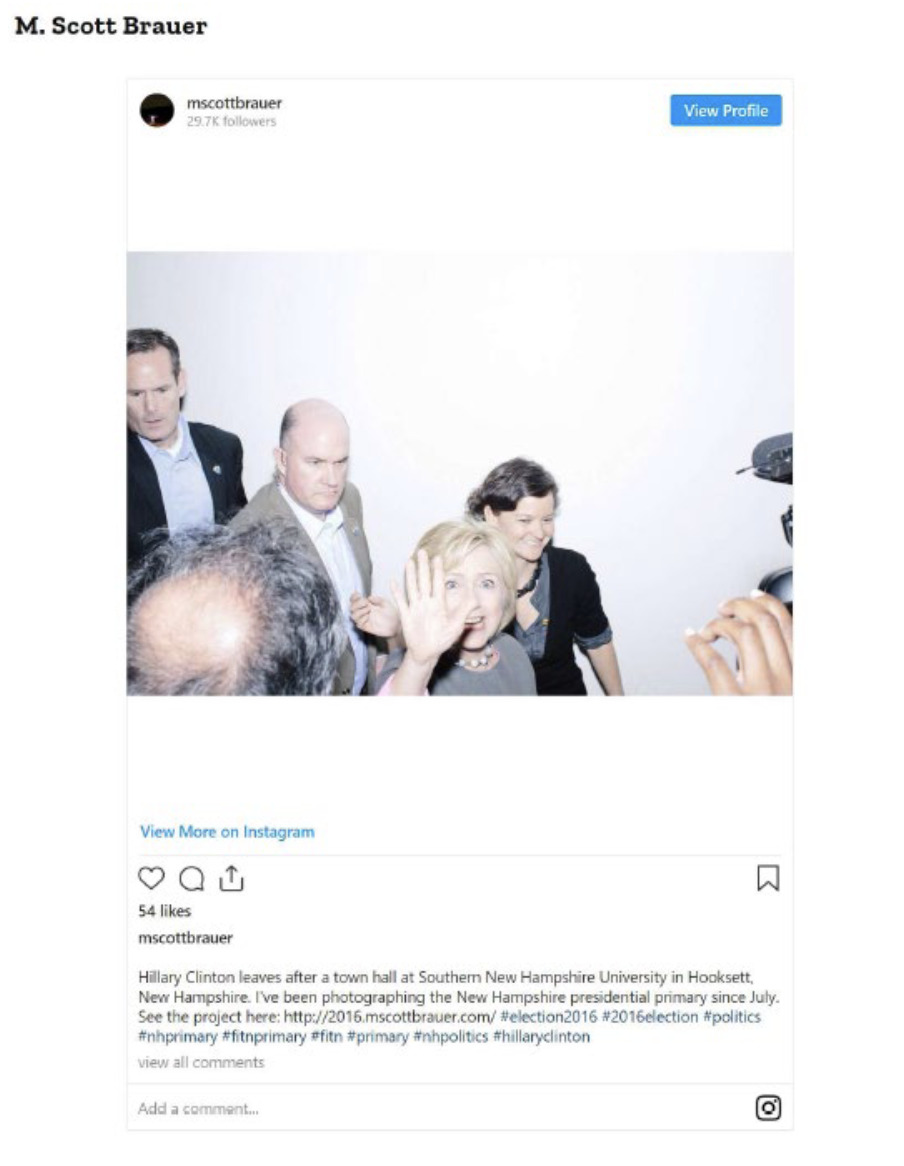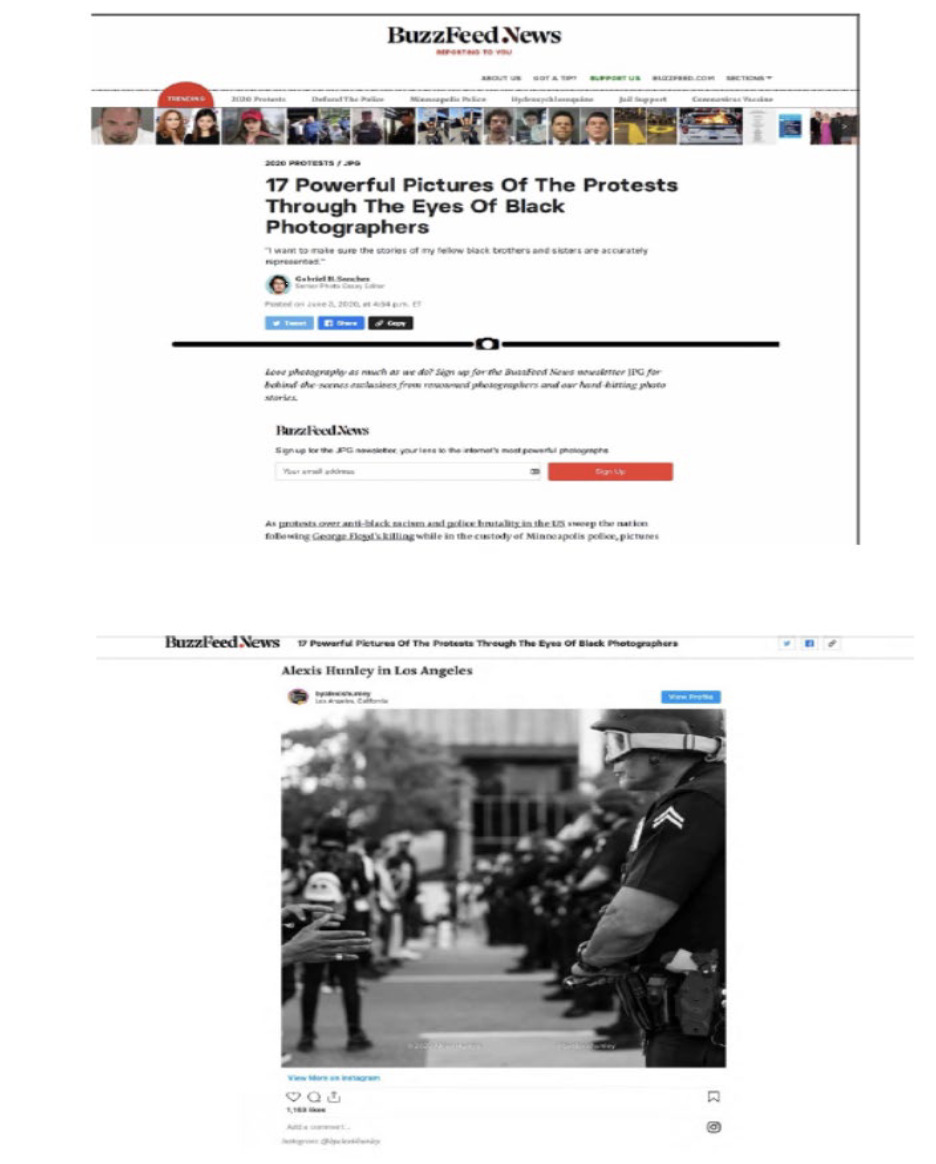“Because the public display right requires that an infringer ‘display a copy,’ user perception is relevant to whether a copy is ‘fixed,’ but not sufficient to establish direct infringement absent the underlying display of a fixed copy.” – Ninth Circuit

Source: Ninth Circuit decision
The U.S. Court of Appeals for the Ninth Circuit yesterday upheld a district court ruling that embedding images from Instagram posts in third-party websites does not constitute copyright infringement.
The case has to do with two photographers’ images that were embedded and posted with articles run by Buzzfeed News and Time from the photographers’ public Instagram accounts. The district court and the Ninth Circuit both cited Perfect 10 v. Amazon as precluding relief.
In Perfect 10, the Ninth Circuit held that thumbnail images displayed in Google and Amazon search results did not constitute copyright infringement because they did not “display a copy” of the copyrighted images as defined by the Copyright Act. Embedded images are not by their nature “fixed in a tangible medium of expression” and therefore do not meet the “Server Test” for determining infringement, which says that “a person displays a photographic image by using a computer to fill a computer screen with a copy of the photographic image fixed in the computer’s memory.”
On appeal, the photographers in the present case, Alexis Hunley and Matthew Scott Brauer (Hunley) argued that the Server Test should only apply to search engine results and also that the Perfect 10 holding is inconsistent with the Copyright Act. But the Ninth Circuit said Perfect 10 was not limited to search engines. “Applying this fixation requirement to the internet infrastructure, we concluded that in the embedding context, a website must store the image on its own server to directly infringe the public display right,” wrote the court. Furthermore, the court has subsequently applied the Server Test outside of the search engine context in a number of cases.

Source: Ninth Circuit
While Hunley argued that other circuits have not adopted the Server Test, the court said this fact is “of little use to Hunley” because, ultimately, “[w]e have not limited Perfect 10 to search engines, and it is too late to argue that it is so limited.”
As to Perfect 10’s conflict with the Copyright Act, Hunley argued that the holding essentially says that “an infringer must violate the copyright holder’s reproduction right before the display right can be violated,” which “renders portions of the Copyright Act superfluous or insignificant.” Other sections of the Copyright Act that “prohibit transmissions by a party, whether or not the party possesses or controls a copy of the work allegedly infringed” or related to “secondary transmissions of a performance or display” also cannot be reconciled with Perfect 10, Hunley said. However, the Ninth Circuit would not substantively address these arguments as they are “foreclosed by Perfect 10,” said the court. While the arguments may have merit in other contexts, said the court, the public display right using embedding is governed by Perfect 10. The court explained:
“In Perfect 10, we did not address the precise arguments Hunley now presses, but we carefully considered display and distribution rights…. Even if we thought, in retrospect, that Perfect 10 created some inconsistencies with other provisions of the Copyright Act, we are not free to overrule Perfect 10 outside of an en banc proceeding unless there has been a change in the statute or an intervening Supreme Court decision.”
Similarly, addressing Hunley’s arguments regarding inconsistencies with the legislative history of the Copyright Act, the proper procedure is to seek rehearing en banc, said the court.
Finally, Hunley argued that Perfect 10 was effectively overruled by the Supreme Court’s holding in American Broadcasting Company v. Aereo. But the court said that case dealt with a different provision of the Copyright Act, namely, the performance right, The Court there analyzed the Transmit Clause and considered whether Aereo performed publicly within the meaning of the Copyright Act, ultimately determining that Aereo did “perform”. Hunley argued that the performance right “has equal value and weight as the display right” and that the two rights can be “easily [] interchanged.” Thus, Instagram must be liable because Aereo was liable, Hunley said. Hunley further argued that “it is the practical, functional perspective of the public viewer, and not hyper technicalities, that must determine whether a particular mode of content or delivery system is infringing or not.” But the Ninth Circuit rejected both arguments, holding that transmitting a performance does not require that the infringer show or perform a copy of the work, while the public display right does require a copy for infringement. The court also said that to find Instagram infringed would require proof of “volitional conduct,” which in Perfect 10 was held to mean “that the entity providing access to infringing content did not directly infringe, but the websites who copied and displayed the content did.” After the Aereo decision, the Ninth Circuit has continued to require proof of “causation [as] an element of a direct infringement claim.”
Addressing Hunley’s perception argument, in which the photographers contended that “because users perceive the same image whether the third-party website duplicates the photo on its own server or embeds the photo from Instagram, both instances should constitute direct infringement,” the court said Hunley was putting too much weight on this aspect of the Aereo decision.
The Supreme Court in Aereo said that “[w]hat happens behind the curtain is . . . irrelevant to the consuming public, and so too should it be irrelevant in the eyes of the law.” But the Ninth Circuit downplayed the significance of this statement and said the Court did not rely on user perception alone to determine that Aereo performed. And in the present case, it is the fixation requirement, rather than the perceptibility requirement, that is most relevant. The court explained:
“Because the public display right requires that an infringer ‘display a copy,’ user perception is relevant to whether a copy is ‘fixed,’ but not sufficient to establish direct infringement absent the underlying display of a fixed copy.”
Both Instagram and Hunley also presented a number of policy arguments for either upholding or overturning the Server Test. Hunley argued the test allows embedders to skirt copyright protections while Instagram argued embedding is necessary for an open internet and that it promotes innovation. While the Ninth Circuit said Hunley is free to request en banc review or appeal to the Supreme Court regarding the Server Test, the panel here is not free to judge the validity of those policy arguments, though it conceded concern: “As citizens and internet users, we too are concerned with the various tensions in the law and the implications of our decisions, but we are not the policymakers,” wrote the court.
The court found Instagram did not directly infringe because it held a nonexclusive sublicense to display Hunley’s photos; it did not secondarily infringe because such a claim would require a showing of direct infringement by third parties and “[b]ecause BuzzFeed and Time embedded—but did not store—the underlying copyrighted photographs, they are not guilty of direct infringement.” The district court thus did not err in dismissing Hunely’s case.

![[IPWatchdog Logo]](https://ipwatchdog.com/wp-content/themes/IPWatchdog%20-%202023/assets/images/temp/logo-small@2x.png)

![[Advertisement]](https://ipwatchdog.com/wp-content/uploads/2024/04/UnitedLex-May-2-2024-sidebar-700x500-1.jpg)
![[Advertisement]](https://ipwatchdog.com/wp-content/uploads/2024/04/Artificial-Intelligence-2024-REPLAY-sidebar-700x500-corrected.jpg)
![[Advertisement]](https://ipwatchdog.com/wp-content/uploads/2024/04/Patent-Litigation-Masters-2024-sidebar-700x500-1.jpg)

![[Advertisement]](https://ipwatchdog.com/wp-content/uploads/2021/12/WEBINAR-336-x-280-px.png)
![[Advertisement]](https://ipwatchdog.com/wp-content/uploads/2021/12/2021-Patent-Practice-on-Demand-recorded-Feb-2021-336-x-280.jpg)
![[Advertisement]](https://ipwatchdog.com/wp-content/uploads/2021/12/Ad-4-The-Invent-Patent-System™.png)






Join the Discussion
No comments yet.